Our five-hour bus trip to Munnar was entertaining (non-stop Bollywood dance sequences), comfortable (clean seats, A/C) and calm (our driver drove the twisty, winding roads in a safe and gentle manner; allowing the impatient masses behind him to pass on blind corners without challenging them to a game of chicken). We left behind blistering heat in Cochi to reach the cool, serene heights of hill station Munnar, former resort to the British Raj elite. Our final ascent to our guesthouse in the hills was by tuk-tuk.
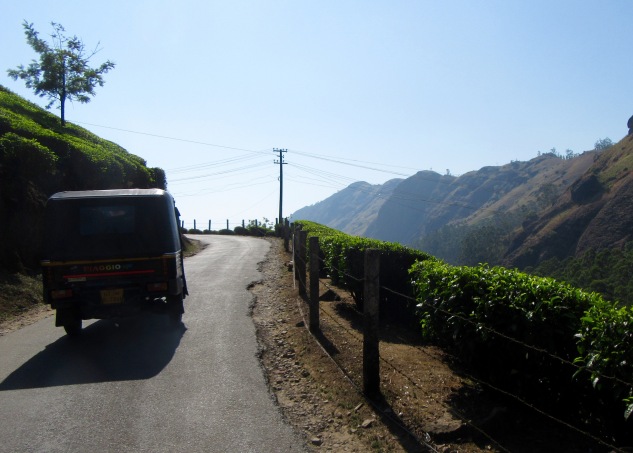
The entrance to Green Magic Hotel.

The view from our hotel balcony.

Green Magic Hotel was a perfect choice for us – just five rooms and run by the sweet and hospitable Robin, who also happens to be a professional chef. Each breakfast and dinner guests met around a table groaning with food. Robin explained the dishes and left us to chat. So far we have met guests from England, Germany, Denmark, Switzerland and India. Last night we had three mother-daughter groups, two friends who had left kids and husbands behind and us.
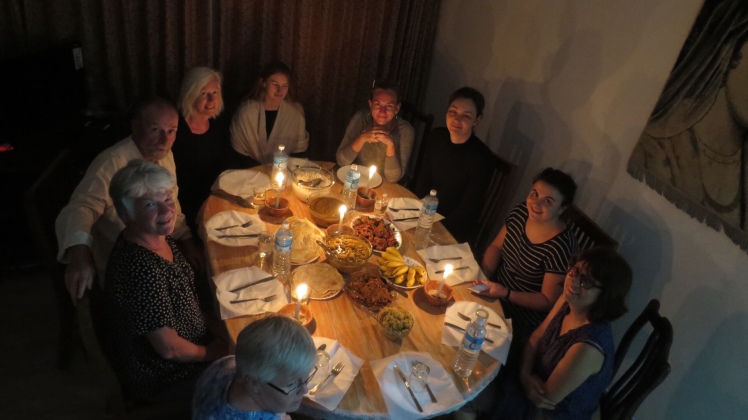
Our guesthouse is set high in the hills about 6 km. from the town of Munnar. At night, it is silent – the stars come out, the temperature drops and we sleep with windows wide open to cool mountain air. We wake in the early morning to raucous birdsong. If this was the turn of the century, we would be in the mountains “taking a cure”.
The area around Munnar is the largest tea-growing region in south India, and the oldest; plantations date back to the late 19th century and plants like this are 75 years old. As you can see, they thrive on poor soil – the gnarly roots appear to grow right into the rock.

From a photographic point of view, our timing was off – the tea pickers were in another area the day we went hiking and they don’t work on Sundays. Picking tea has not been mechanized – each leaf is still picked by hand. Just the shiny light green top leaves are picked – the rest are left behind.
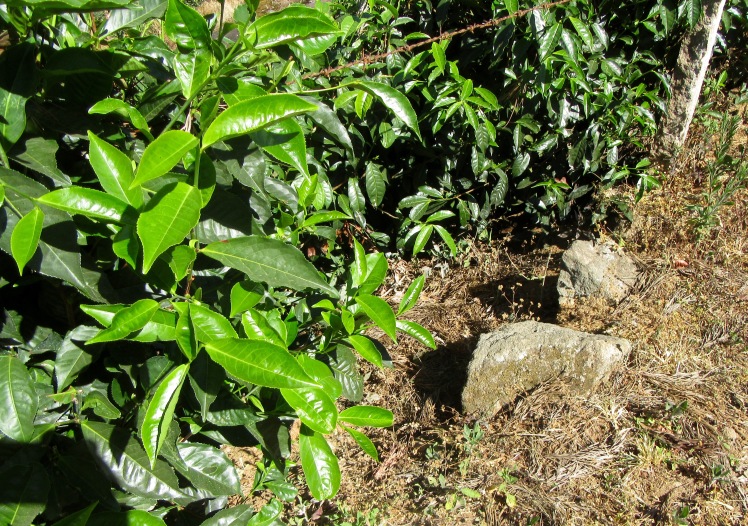
The rows of tea plants are trimmed like miniature ornamental hedges – immaculate and glossy – they stretch for as far as the eye can see.
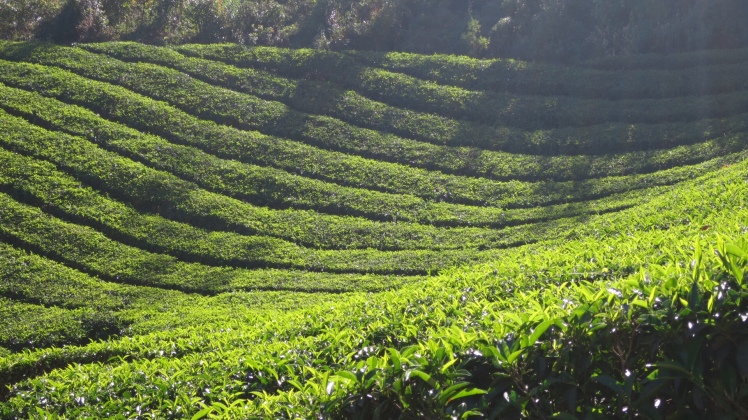
Munnar is well-known for its “soft trekking” – unlike the Himalayas, the Western Ghat Mountain range is rounded and more gentle for hiking. It is possible (but not advisable) to head out for the hills without a guide. The paths are wide and easy to navigate and the incline is gentle and gradual enough for beginners. There are 25- 30 km. treks, but we opted for a five-hour, 15 km. hike. Our guide Ramish met us at our guesthouse at 7:30 am, and within 15 minutes we had reached the trail, bitterly regretting not having brought a coat or hoodie. There was frost on the plants and ice on the ground. Munnar frequently gets below-zero overnight temperatures in December and early January, but as is the case in the rest of the world, Munnar is experiencing climate change and unseasonable weather. We don’t stay cold for long, and soon the rewards of the hike begin to unfold.

The mountain range layers away in all directions, from deep purple to forest green to the palest lavender. For the first time since we’ve arrived in India, the air is pure and the sky is bright blue.
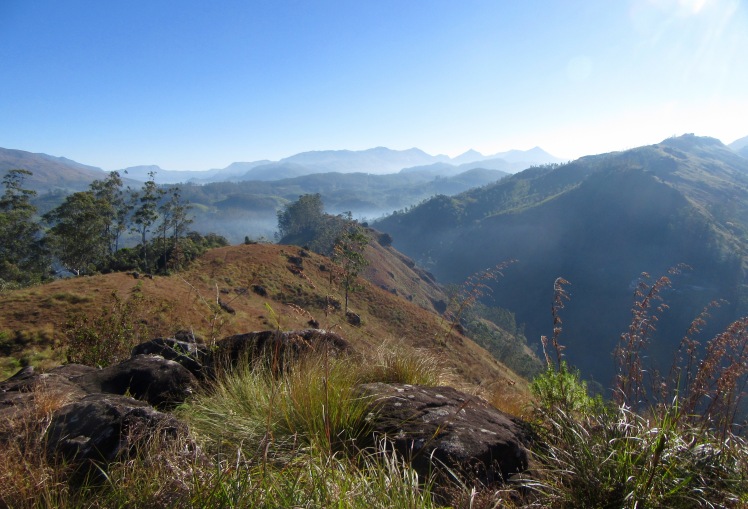
We walked past a group of people resting on a boulder. Some of them were sitting right on the edge, with feet dangling over the abyss.
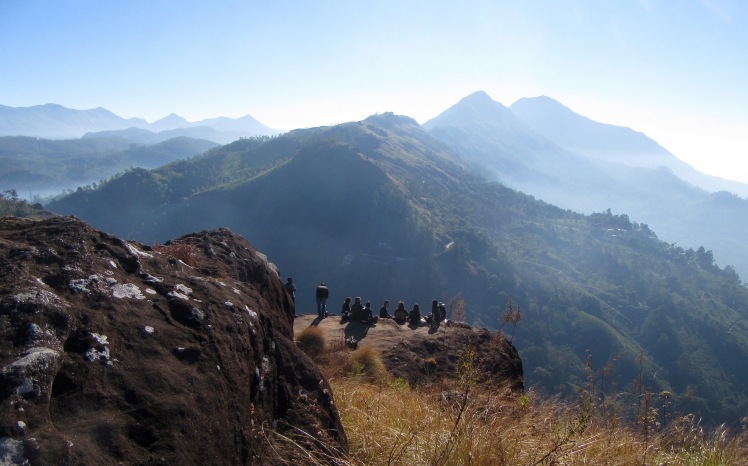
A rare sight at this elevation – a high tree and some shade.
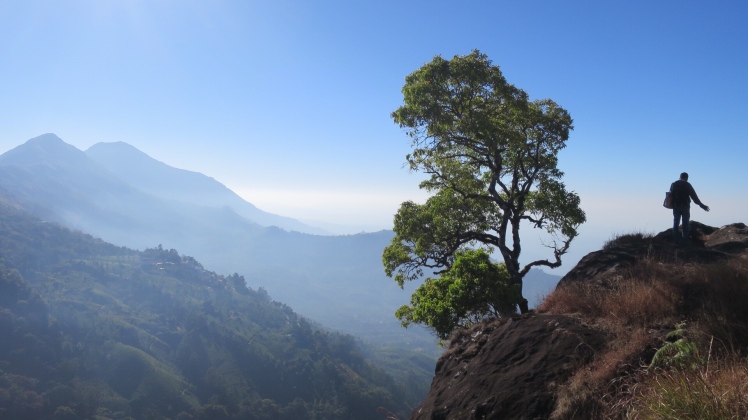
We stopped for a water break and to admire the view. A long line of blue uniforms began to appear – the Navy cadets were heading toward us in full force. About 50 young men trooped by and settled in on another rock just in front of us. The drill began and so did the push-ups. We had a great laugh watching some of the guys trying to fake it after about 10 push-ups – they have a way to go yet in their training. We found out they were from Delhi – an exuberant group of 20-year-olds down for a weekend camp.
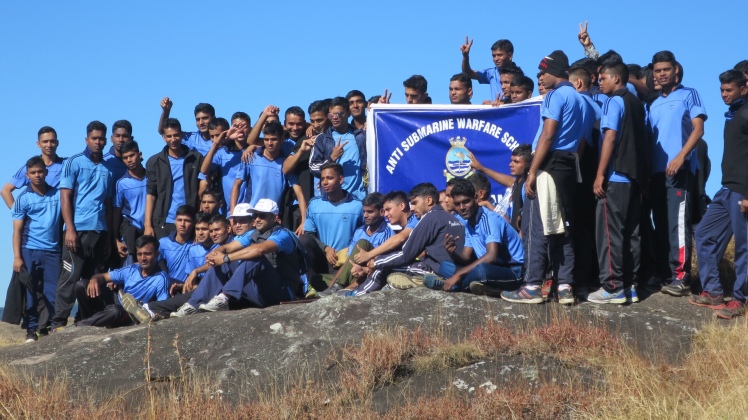
Ramish points out Anamudi Mountain – at 2695 m., it is South India’s highest mountain peak. The mountain is in the background – that’s Ramish in the foreground; a little the worse for wear for having helped an old lady down a steep incline. After I slipped and nearly fell a couple of times, he became alarmed. He stepped in front of me, grabbed my left hand over his shoulder and performed a cross between a fireman’s carry and a human shield to bring me to safety. My trusty Keen sandals are normally solid, but they would not grab the talcum powder surface of the dusty slope.

We spent two days with Ramish and got to know him a little. His English is not great, but he tries very hard and really wants to improve to become a qualified tour guide. Our host Robin recommended him (they are good friends), and we were happy with his services, but we got a bit of an insight into the challenges of his life.
Ramish is 31 years old, has a wife and two young children and has lived in Munnar his whole life. He has a night job with the tea factory; he works from 10 pm to 7 am and he and a friend switch off duties during the night so they can take turns napping (probably not an encouraged practice.) He earns 300 rupees each shift – about $6 Canadian dollars. His company also pays his health care, his children’s school costs and gives him a house to live in until he reaches the mandatory retirement age of 58. Hopefully in the intervening years he will have made other arrangements for a home. To supplement his income, he bought a tuk-tuk and drives during the day. Three to four times a week during tourist season, people like us pay him 1200 rupees ($25) for five hours touring – four times his salary at the tea factory. By many Indian standards, he is doing fine. The challenge for Ramish is that he is bright and ambitious but he only has Grade Nine education. When we stopped for lunch, we sat by a guide and his Italian guests and we watched Ramish observe them. That guide was obviously educated, fluent in English, and polished in dress and demeanour. How does our Ramish find the time and the opportunity to improve his lot? Both Stephen and I felt his longing for more – it was palpable. Ramish is charming, decent, very hard-working and bright – in Canada that would be his ticket to a comfortable life. Still, he seems to be a happy man – young, strong, self-sufficient, surrounded by community and living in a beautiful place.
Heading down the mountain and through the tea plantation; Ramish walks this almost every day and never gets tired of the view.

Ramish took us out in his tuk-tuk on another day for a tour of the area. The draw to Munnar is the natural beauty, the trekking, the cool, clean air and the escape from the chaos of urban India. Munnar’s tourism board feels the need to gild the lily by marketing a raft of unappealing and pointless attractions, such as a garden centre with a couple of acres of parched dahlias and listless roses. We passed on that, so Ramish headed for Mattupetty Dam. He instructed us to walk over the dam and “come back in 10 minutes.” Dutifully we obliged, wondering why we were staring through a chain-link fence to garbage and murky green water. We walked along the lake for a bit and headed back to the tuk-tuk.

There are bison and wild elephants in the area, and although we saw dried-up evidence of animal visits on the pathways, we did not see so much as a squirrel while we were driving and hiking. As luck would have it, a mum and her baby elephant appeared, but sadly too far away from us to get a closer view. They were way down on the beach while we were way up in the hills. But still, it was a squinty-eyed thrill to see them.

Ramish pointed out a low shrub called Kurinji that blooms just once every 12 years, and 2018 is the magic year for the next mass blooming. Apparently the area around Munnar has the best viewing, but I’m hoping we will be able to see this flower in other parts of India as well – they are due to bloom in March and April.
In the meantime, the hills were filled with giant colourful flowers – red, blue, yellow – names unknown.

Munnar’s town market is quite lovely – filled with such exotica as banana flowers.
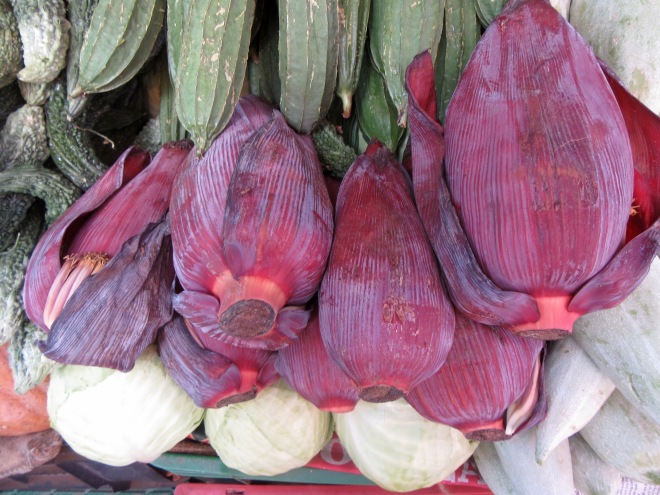
Just a few stalls down, we watched fresh banana chips being made – scraped from a mandolin into boiling oil. We couldn’t resist this perfect Indian snack.
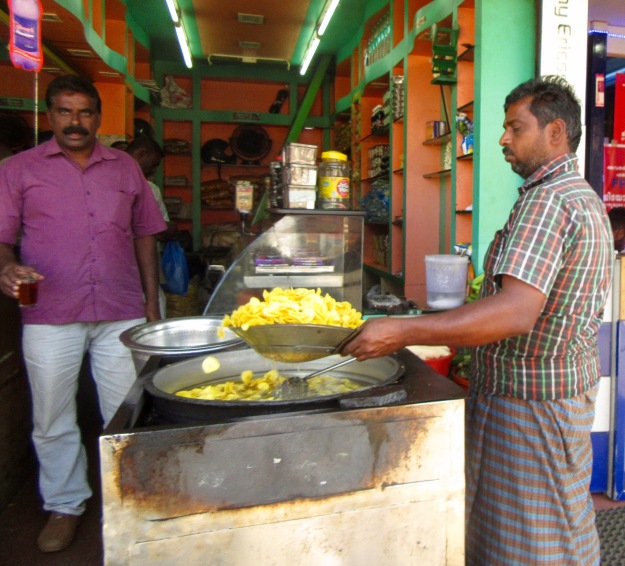
Today, we went for a six-km. walk into the plantations and hills around our guesthouse. We ran into these characters – here on holiday from Toronto. The gentleman with the Blue Jays cap has lived in Toronto for six years and works as a chef with Aramark – the company that provides food for Rogers Stadium. He is originally from this area, and obviously could not resist doing what you can’t do in Canada – sit on the top of a Jeep while driving down a steep mountainside.
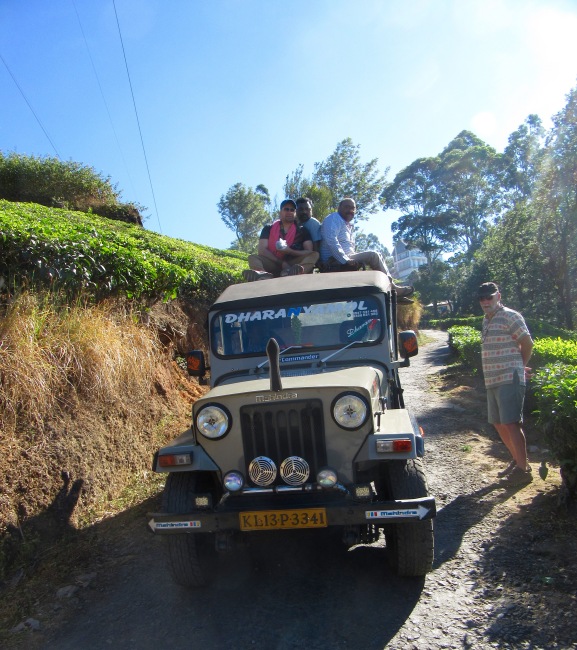
One of the many viewpoints from the winding paths leading to the village below.
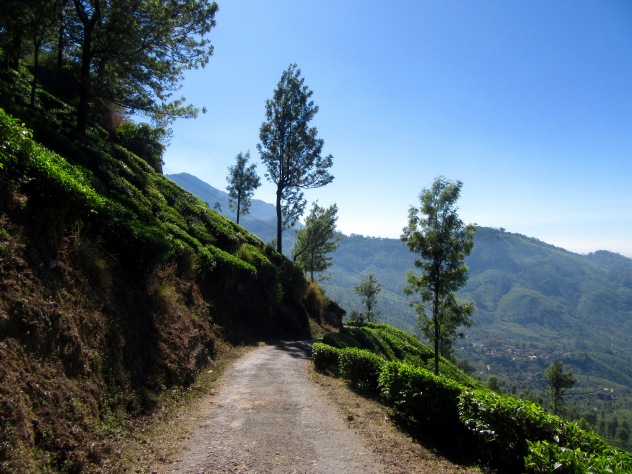
And again…

Our time in Munnar has been picture-perfect. We had planned to visit Periyar Reserve, and nearby Thekkady, but learned from our host that the 900 elephants there are no longer easy to view. Three years ago, a couple was trampled to death by an elephant when the flash on their camera startled him. After that tragedy, the park closed trekking into certain areas of the park, and elephant sightings are now very rare.
Disappointing, but there are a number of other great animal reserves in India, which we will hopefully visit. Tomorrow we head for Alleppey, which is the hub of Kerala’s backwaters.
Again, love the wonderful descriptions and even better pictures. What a trip!!!
LikeLike
It has been quite the trip so far. We are now fully in India.
LikeLike
Looks amazing! I’m still in Panchakarma land….losing myself in the nicest way.
LikeLike
I’ve been thinking about you a lot, Kathryn – so curious to hear about your experiences. It sounds very positive – I’ll email you. xo
LikeLike
I am loving your posts and pictures
LikeLike
Good to hear, Kelly – hopefully you’ll make plans for a trip one day!
LikeLike
The photos you have taken are breathtaking! What a difference from previous locations. I can almost smell the clean mountain air!
LikeLike
That’s what is so interesting to us about India – the diversity. We won’t have mountain air again until late March or early April, but we’re heading into the lowlands now, then on to another beach area, then a French colonial city, etc. etc. No possibility of getting bored.
LikeLike
what wonderful pictures, thanks for the narrative…we are all with you x
LikeLike
And you are with us, Lesley. That is our joy with the blog – it keeps us connected to everyone.
LikeLike
Well Munnar sounds more like your kind of place. How glorious.
LikeLike
It was amazing, Nikki. Our time in Munnar was our most memorable so far.You were on my mind as we were hiking, only you would have gone for the 25 km. trek, and worn proper footwear.
LikeLike
Thanks for telling us about the people you meet. My mind’s India is the Taj Mahal over here, a tiger over there, an elephant down there, and maybe a few yogis scattered around – it’s nice to hear about the locals in the places you visit, how they differ from us, and are the same.
LikeLike
Meeting the locals has been such a highlight, and having the opportunity to stay in guesthouses and homestays has really been a treat. It’s also such a big part of the trip to meet other travellers and hear their stories.
And people really are the same in the most important ways.
LikeLike
As usual interesting, informative, good photos and sensitive commentary. I was struck by your comments about Ramesh, and we just met a similar situation in Nicaragua with one of our guides there. Locked into an economic situation way below his capabilities. You realize the huge amount of talent the world must contain, and how little of it gets to reach anywhere near its capacity because of poverty in countries like India and Nicaragua. Continue to live vicariously through your wonderful blog. ps, Actually, the true expression is paint the lily (Shakespeare, King John ) “To gild refined gold, to paint the lily, to throw a perfume on the violet, to smooth the ice, or add another hue unto the rainbow, or with taper-light to seek the beauteous eye of heaven to garnish, is wasteful and ridiculous excess.”
LikeLike
Thanks for the origin on the expression “gild the lily”, since my grasp of Shakespeare is quite weak.
LikeLike